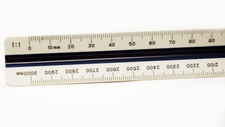Metric Measurements

TEKS Objective
The student is expected to collect, record, and analyze information using tools, including calculators, microscopes, cameras, computers, hand lenses, metric rulers, Celsius thermometers, mirrors, spring scales, pan balances, triple beam balances, graduated cylinders, beakers, hot plates, meter sticks, compasses, magnets, collecting nets, and notebooks; timing devices, including clocks and stopwatches; and materials to support observation of habitats of organisms such as terrariums and aquariums.
Essential Understanding
The student knows how to use a variety of tools, materials, equipment, and models to conduct science inquiry.
Science Background
Origin of the Metric System: US Metric Association (website) - Helpful, detailed explanation of the history and adoption of the metric system as an internationally agreed set of units for measurement.
Origin of the Metric System
US Metric Association, http://lamar.colostate.edu
SI (International Systems of Units) Measurement Reference Chart: Holt, Rinehart and Winston (PDF) - Identifies basic units of the metric system, including prefixes used to define smaller and larger quantities. Includes a conversion table for SI to English (or standard) units of measurement.
Signature Lesson
Estimation and Measurement: Science NetLink (website) - Students use metric measurement tools collect, record and analyze data, and then discuss why it is important to have standardized units of measurement.
Estimation and Measurement
Science NetLink, http://sciencenetlinks.com
Metric Mania: The Science Spot (website) - Series of metric lessons on length, mass, volume, density, temperature and conversions. Students learn how to use metric tools and the metric system as they collect, record, and analyze information.
- Supporting Lessons
- Extensions
- Assessment Ideas
- Literature Connections
- Related
TEKS - Additional Resources
Supporting Lessons
Metric Madness: BioEd Online (website) - Students rotate through stations or centers in groups, using different tools and applying the skills of estimation and metric measurement in an engaging format. This lesson can be adjusted to meet the measurement objectives of the grade level.
Elaboration Lessons and Extensions
Metric Concentration: Worksheets PLUS (website) - Students learn metric prefixes, units and symbols while calculating and recording length, areas, radius, perimeters, etc.
Metric Concentration
Worksheets PLUS, http://www.worksheetsplus.com
Assessment Ideas
Offer students metric tools of measurement and ask which they would choose to measure the length of the chalkboard, a chair, a pencil, the wall, etc. Even if students are not able to measure accurately with these tools, the exercise will help them to understand that some measuring tools will be more useful than others, depending on the object being measured.
Literature Connections
How Big is the Lion? Accorsi, William (ISBN-13: 978-0761155409)
Measuring Penny. Leedy, Loreen (ISBN-13: 978-0805065725)
How Big is a Foot? Myller, Rolf (ISBN-13: 978-0440404958)
Me and the Measure of Things. Sweeney, Joan (ISBN-13: 978-0440417569)
Length. Pluckrose, Henry (ISBN-13: 978-0516454535)
Additional Resources
4th Grade Measurement Worksheets, Lessons, and Printables: edHelper.com (website) - Links to many activities and student pages that teach measuring skills, including work with the metric system. Requires (free) teacher registration.
4th Grade Measurement Worksheets, Lessons, and Printables
edHelper.com, http://www.edhelper.com
Measurement Lessons, Fourth Grade: Learning Today (website) - Interactive online tutorials, including games, practice activities and assessment, that teach fourth grade students about measurement.
Measurement Lessons, Fourth Grade
Learning Today, http://www.learningtoday.com
TEKS Navigation
Grade 4
Need Assistance?
If you need help or have a question please use the links below to help resolve your problem.

Comments